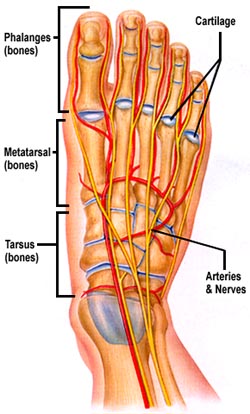Foot Arthritis
 Arthritis is a general term for a group of more than 100 diseases. “Arthritis” means “joint inflammation.” When it affects joints of the foot it can produce swelling and pain, and may eventually result in deformity, loss of joint function, and decreased ability to walk.
Arthritis is a general term for a group of more than 100 diseases. “Arthritis” means “joint inflammation.” When it affects joints of the foot it can produce swelling and pain, and may eventually result in deformity, loss of joint function, and decreased ability to walk.
The most common form of foot arthritis is osteoarthritis. For more information on this topic, read “Osteoarthritis of the Foot and Ankle.”
Similar symptoms may be caused by another form of arthritis, rheumatoid arthritis. Arthritis that affects the joint of the big toe is known as “hallux rigidus.”
Information provided by American College of Foot and Ankle Surgeons
New Ankle Arthritis Treatments Help Boomers Stay Active
Foot & Ankle Surgeons Discuss Arthritis Surgical Advances
There’s good news for active older adults who are plagued with arthritic ankles. Surgeons are re-thinking treatment approaches for end-stage ankle arthritis. Baby Boomers are more active than ever and don’t want to be held back by painful arthritis. While in the past pain-relieving ankle fusions were the gold standard for care, new surgical techniques including arthroscopic ankle surgery, total ankle joint replacements and bone or cartilage replacement are offering hope for those wanting to remain active.
These advancements come at an opportune time since foot and ankle surgeons are seeing more patients with end-stage ankle arthritis as the population of older adults increases. End-stage ankle arthritis is a painful condition and most often occurs after a traumatic injury, history of chronic sprains, or in patients with diseases such as rheumatoid arthritis. “A decade ago treatment options were limited; patients either lived with the pain or underwent an ankle fusion,”. “But today, because of the medical advancements and new surgical techniques, Baby Boomers suffering from arthritis have additional, viable treatment options to keep them on their feet and enjoying their active lifestyle.”
One treatment option that has seen some of the most advancement is the use of ankle implants. “While still changing, the quality and design of the implants have drastically improved over the years,”. “Implants are now even more customized to the patient’s size, gender and uniqueness of their arthritis; it’s no longer a-one-size-fits-all world. This is especially important for maintaining functionality and range of motion in the ankle.”
The clear message for those suffering with debilitating arthritis is that there are new options available. “It is recommended that patients consult with a foot an ankle surgeon who can provide them with the best course of treatment for the individual case.”

